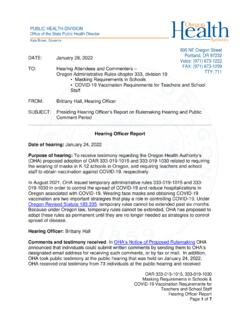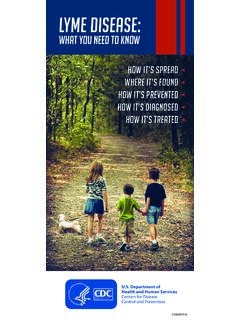Transcription of Sample Letter from U.S. EPA Administrator to Governors ...
1 Sample Letter Page 1 of 3 December 2, 2021 Dear Governors , President Biden signed the Bipartisan Infrastructure Law on Monday, November 15, 2021. This i s a big and bold investment in our nation s i nfrastructure, including a historic $60 billion investment in key programs and initiatives implemented by the environmental protection agency to build safer, healthier, cleaner communities. This critical funding means that more Superfund sites will be cleaned up faster; blighted and polluted sites across America will be redeveloped to contribute to local economies once again; the nation s school bus fleet wil l be made cleaner; a nd people wil l be put to work revitalizing aging water infrastructure in communities throughout the country.
2 The law s investment in water is nothing short of transformational. It includes $50 billion to the EPA to strengthen the nation s drinking water and wastewater systems the single largest investment in water that the federal government has ever made. I write to share my commitment to forging a productive partnership between the EPA and the states to maximize the impact of these funds in addressing urgent water challenges facing communities. The majority of the water infrastructure dollars will flow through the State Revolving Funds, and, as a former state environmental regulator in North Carolina, I know firsthand that states, tribal nations and the EPA have successfully worked together to steward more than $190 billion in SRF funds since 1988.
3 For decades, the SRFs have been the foundation of water infrastructure investments, providing low-cost financing for local projects across America. An effective partnership in deploying these funds will be essential to unlocking the full potential of this moment. Assistant Administrator Radhika Fox will soon be issuing national program guidance from the EPA s Office of Water to state primacy agencies for the use of water infrastructure funding through the BIL. In this Letter , we share the agency s aspirations for what we can achieve by working together: Target resources to disadvantaged communities.
4 Every state in America has disadvantaged communities rural, urban, suburban that have deeply rooted water challenges, whether it is too much, too little or poor-quality water. These communities have never received their fair share of federal water infrastructure funding. Through the Bipartisan Infrastructure Law, states have an unprecedented opportunity to correct this disparity. Make rapid progress on lead-free water for all. There is no safe level of exposure to lead, yet millions of families across America still suffer from lead contamination in their drinking water.
5 States have a historic opportunity to use the dedicated $15 billion for lead service-line replacement in the Bipartisan Infrastructure Law, while leveraging multiple other available funding streams, to get the lead out once and for Letter Tackle forever chemicals. The Bipartisan Infrastructure Law provides an unprecedented level of funding dedicated to addressing perfluoroalkyl and polyfluoroalkyl substances and other emerging contaminants. States can use these resources to provide relief to communities on the front lines of PFAS , please fin d the estimated 2022 state allotments of BIL funds through the SRFs significant resources that we know will go a long way toward achieving our shared goals.
6 The enclosure summarizes the first-year allotment of nearly $44 billion in total SRF funding that will be provided to states, tribes and territories over the next five years through the Bipartisan Infrastructure Law. Target Resources to Disadvantaged Communities It is a top priority for the EPA to ensure communities that have historically struggled to access SRF funding are prioritized. During my recent Journey to Justice tour, where I traveled throughout Mississippi, Louisiana and Texas, I saw and heard firsthand the range of systemic barriers that low- income people and communities of color face in accessing federal infrastructure funding.
7 For too long these communities have been left behind by both federal and state governments. From Jackson to Houston, New Orleans to St. James Parrish, environmental -justice communities are concerned that they will be shut out of accessing water infrastructure funding from the SRFs. States and the EPA can and must do better with the Bipartisan Infrastructure Law. We know that economically stressed communities small, large, rural, urban and suburban often lack the financial, technical and managerial capacity toaccess traditional SRF loans.
8 Almost half of the Bipartisan Infrastructure Law s nearly $44 billion inSRF funds are eligible for distribution as grants or fully forgivable loans. States have the power to openthe door to disadvantaged communities who for too long have struggled to compete for financing fromtraditional SRFs and other loan the implementation of the Bipartisan Infrastructure Law, as the EPA evaluates and approves states intended use plans, the agency strongly urges states to maximize the potential to remove barriers and prioritize the distribution of grant funds to disadvantaged communities.
9 To further aid states, tribes, local governments and water systems, the EPA will also provide technical assistance to help disadvantaged communities overcome barriers in applying for and receiving loans and grants through the SRFs. Make Rapid Progress on Lead Free Water for All President Biden has set an ambitious goal of replacing 100 percent of the nation s lead service lines. The EPA views the $15 billion in dedicated funding for lead service-line replacement in the Bipartisan Infrastructure Law as a centerpiece of the strategy to deliver lead-free water for all Americans.
10 As states i nitiate planning for the use of these funds, the EPA urges states to target these funds to communities who are disproportionately impacted by lead in drinking water. Moving forward, the EPA s strategy to address lead in drinking water will prioritize communities with the highest lead levels and those with environmental -justice concerns. I urge you to join us in this commitment. The EPA will be looking for intended use plans that affirmatively target these funds to replace both public and private lead service lines, especially in disadvantaged communities that lack access to other sources of funding.













